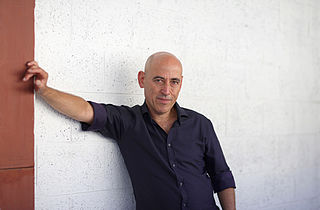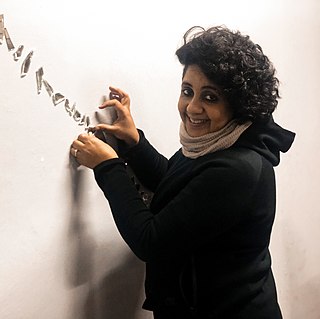Related Research Articles

Yocheved (Juki) Weinfeld is an artist, museum educator and developer of interactive exhibitions for children. She studied at the Tel Aviv University and the State Art Teacher's College (Israel); at the Hebrew University of Jerusalem and at the Michaelis School of Art at the University of Cape Town in South Africa).
Rachel Adler is Professor Emerita of Modern Jewish Thought and Judaism and Gender at Hebrew Union College, at the Los Angeles campus.
Judith Margolis is an Israel-based American artist working visually in paintings, drawings, artist's books and multi-media collages. In her art and writing she "explores tensions between consciousness, feminism, and religious ritual tradition".
Susan Silas is a visual artist working primarily in video, sculpture and photography. Her work, through self-portraiture, examines the meaning of embodiment, the index in representation, and the evolution of our understanding of the self. She is interested in the aging body, gender roles, the fragility of sentient being and the potential outcome of the creation of idealized selves through bio-technology and artificial intelligence.

Moshe Gershuni was an Israeli painter and sculptor. In his works, particularly in his paintings from the 1980s, he expressed a position different from the norm, commemorating the Holocaust in Israeli art. In addition, he created in his works a connection between bereavement and homoerotic sexuality, in the way he criticized society and Israeli Zionism-nationalism. He was awarded the Israel Prize for Painting for his work in 2003, but in the end it was revoked and he was deprived of receiving the prize.

The Sherwin Miller Museum of Jewish Art (SMMJA) in Tulsa, Oklahoma, was founded in 1966 as the Gershon & Rebecca Fenster Museum of Jewish Art. From its inception until 1998, Tulsa's Congregation B'nai Emunah Synagogue housed the museum. Sherwin Miller was the museum's first curator. In 2000, the museum was renamed the Sherwin Miller Museum, and it moved to its present location at 2021 E 71st St in Tulsa, OK 74136 on the Zarrow Campus of the Jewish Federation of Tulsa in November 2004. The Sherwin Miller Museum, which houses the largest collection of Jewish art in the Southwestern United States, received accreditation by the American Alliance of Museums in 2013.

Nahum Tevet is one of the leading Israeli artists whose work was among the earliest to respond to the minimalist canon by introducing into his installations everyday domestic objects, metaphors and images like in: Corner (1973-4) and Arrangements of Six Units.

Visual arts in Israel or Israeli art refers to visual art or plastic art created by Israeli artists or Jewish painters in the Yishuv. Visual art in Israel encompasses a wide spectrum of techniques, styles and themes reflecting a dialogue with Jewish art throughout the ages and attempts to formulate a national identity.
Barbara Kirshenblatt-Gimblett is a scholar of Performance and Jewish Studies and a museum professional. Professor Emerita of Performance Studies at New York University, she is best known for her interdisciplinary contributions to Jewish studies and to the theory and history of museums, tourism, and heritage. She is currently the Ronald S. Lauder Chief Curator of the Core Exhibition and Advisor to the Director at POLIN Museum of the History of Polish Jews in Warsaw.
Judith K. Zilczer is an American art historian and former museum curator. She is known for her work with artists such as Horace Pippin, Raymond Duchamp-Villon, Willem de Kooning, and Richard Lindner. Zilczer was interested in the connections between music and art, which she described as "the mystical strain of artistic synesthesia." She curated an exhibit titled "Visual Music: Synaesthesia in Art and Music Since 1900". Zilczer served at the Hirshhorn Museum and Sculpture Garden (HMSG) in various capacities from 1974-2003. In 1978, she organized for the Hirshhorn Museum "The Noble Buyer:" John Quinn Patron of the Avant-Garde, a detailed account of one of the most important collections of modern art assembled in the early years of the 20th Century. From 1992 to 2003, she was Curator of Paintings.

Israeli sculpture designates sculpture produced in the Land of Israel from 1906, the year the "Bezalel School of Arts and Crafts" was established. The process of crystallization of Israeli sculpture was influenced at every stage by international sculpture. In the early period of Israeli sculpture, most of its important sculptors were immigrants to the Land of Israel, and their art was a synthesis of the influence of European sculpture with the way in which the national artistic identity developed in the Land of Israel and later in the State of Israel.
Jewish Museum Milwaukee is located in Milwaukee, Wisconsin, USA. The Jewish Museum Milwaukee's mission is to preserve and present the Jewish experience through the lens of Greater Milwaukee, and to celebrate the continuum of Jewish heritage and culture. The archives, exhibitions, programs and publications inspire public appreciation for the diversity of Jewish life in a local and global historic context.
Malcah Zeldis is an American folk painter. She is known for work that draws from a mix of biblical, historical, and autobiographical themes.
The Jerusalem Center for the Visual Arts (JCVA) is an international artists-in-residence program that hosts artists and curators in Israel.

Erica Lehrer is an anthropologist, curator, and academic specializing in post-Holocaust Jewish culture, museum studies, ethnography, and public scholarship. She is Associate Professor of History and Sociology/Anthropology at Concordia University, where she holds a Canada Research Chair in Museum and Heritage Studies and serves as director of the Curating and Public Scholarship Lab at Concordia University.
Gesa Ederberg is a German rabbi; she became the first female pulpit rabbi in Berlin in 2007 when she became the rabbi of the New Synagogue, Berlin in the former East Berlin. Her installation as such was opposed by Berlin's senior Orthodox rabbi Yitzchak Ehrenberg.

Miriam Cabessa is an Israeli-American painter, performance and installation artist, winner of the 2022 Israeli Ministry of Culture Lifetime Achievement Award. Cabessa was born in Morocco, raised in Israel, and has lived and worked in New York City since 2000. Her slow action painting has been internationally recognized since 1997 when she represented Israel at the Venice Biennale. Over the past two decades, she has abstained from using brushes, opting to make marks with objects and her body. Her imagery ranges from organic to mechanistic with surfaces that are both haptically handmade and digitally serene. Cabessa has shown extensively in the U.S., Europe, and Israel.

Vibha Galhotra, born 1978 is an Indian conceptual artist based in New Delhi. Her work includes large-scale installations, sculptures, drawings, films that explore themes of ecological and environmental concerns. Her works address the shifting topography of the world under the impact of globalization and growth. She sees herself as being part of the restructuring of culture, society and geography – of New Delhi, and the world.

Rochelle G. Saidel is an American writer and researcher. She founded the Remember the Women Institute in 1997 and currently serves as its executive director.

Hadar Gad is an Israeli artist.
References
- ↑ Kestenbaum, Gloria (2013-02-26). "The Eruv: Staying within Bounds". The Jewish Week.
- ↑ McBee, Richard (2013-01-11). "It's a Thin Line: The Eruv and Jewish Community in New York and Beyond". The Jewish Press.
- ↑ Amitai Adler (November 2009). "Living with the "Arational"" (PDF). Sh'ma: A Journal of Jewish Responsibility: 14.
- ↑ Kestenbaum, Gloria (2014-01-16). "Anne Frank And Her Disciples". The Jewish Week.
- ↑ Verwer, Yona (2009-12-03). "Temple Talismans". ZEEK.
- ↑ Mizel Museum
- ↑ Artist in the Marketplace
- ↑ Sacred Voices at the Canton Museum
- ↑ Silent Witnesses
- ↑ Plate, S. Brent (2014-08-18). "Religion Is Alive and Well in Contemporary Art". The Huffington Post.
- ↑ Lagnado, Caroline (2013-10-29). "Two Artists Address Difficult Issues In Tribeca Exhibit". The Jewish Week.
- ↑ Soltes, Ori Z. (2010-02-22). "Slavery and the Holocaust". Zeek.
- ↑ Schechter, Basya (2014-05-02). "The Self and Creativity". Sh'ma.
- ↑ Wecker, Menachem (2007-03-21). "Jewish Women Artists Talk About Their Work". The Jewish Press.
- ↑ PS 122
- ↑ S.A.R. Academy Special Programs
- ↑ The Jewish Waltz with Planet Earth Archived November 27, 2014, at the Wayback Machine
- ↑ Kestenbaum, Gloria (2014-01-16). "Anne Frank And Her Disciples". The Jewish Week.
- ↑ Burston, Timna (2012-10-28). "Text and Context". Jewish Eyes on The Arts.
- ↑ Rank, Jonah (2012-12-04). "Shenanigans". Jewish Eyes on The Arts.
- ↑ Newelt, Jeff (2013-03-12). "Ghetto Mishpucha: A Crypto-Jew and the Birth of Hip Hop". HEEB.